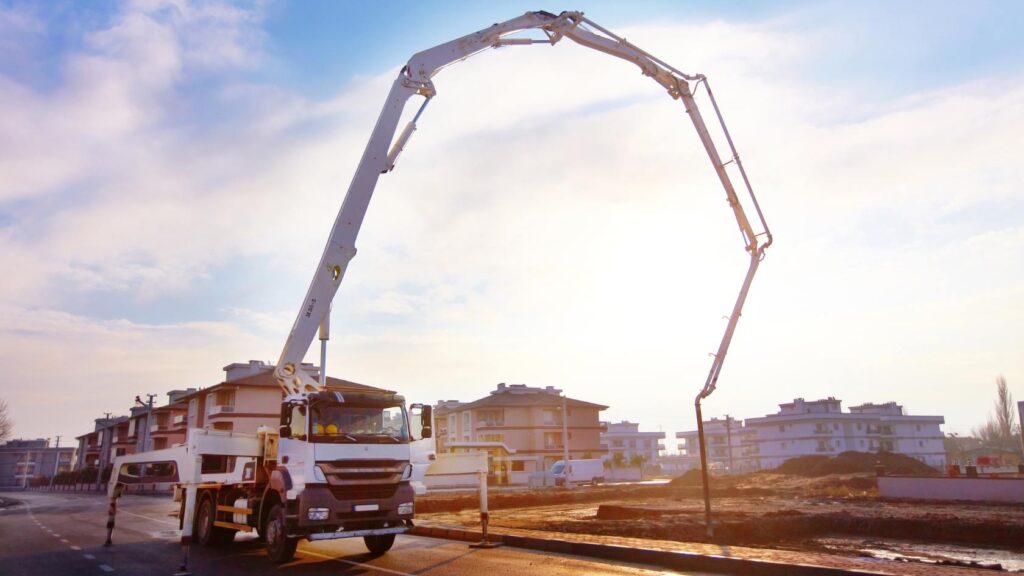In the world of construction, efficiency and productivity are key to completing projects on time and within budget. One of the essential tools that can significantly boost productivity on site is a concrete pump. These machines play a crucial role in delivering concrete quickly and efficiently to various parts of a construction site. If you’re wondering how to enhance productivity on site with the best concrete pumps, this article is your go-to guide. We’ll explore the types of concrete pumps, their benefits, and how choosing the right pump can make a big difference in your construction projects.
1. What is a Concrete Pump?
A concrete pump is a piece of machinery used to transport liquid concrete from the mixer to the desired location on a construction site. It works by using pressure to move concrete through pipes, allowing it to be poured exactly where it’s needed. This method is much more efficient than traditional methods of moving concrete, such as wheelbarrows or cranes, especially for large-scale projects.
Concrete pumps come in various types, each designed for specific tasks and site conditions. Understanding the different types of concrete pumps can help you choose the right one for your project.
2. Types of Concrete Pumps
There are primarily two types of concrete pumps used on construction sites: boom pumps and line pumps. Each type has its own set of advantages and is suited for different types of projects.
- Boom Pumps: These are large, truck-mounted pumps with an extending arm (or boom) that can reach high and far. They are ideal for projects where the concrete needs to be delivered to elevated or hard-to-reach areas, such as multi-story buildings or large foundations. The boom allows for precise placement of the concrete without needing to reposition the pump.
- Line Pumps: Also known as trailer-mounted pumps, these are versatile and can be used in various settings. They consist of a pump mounted on a trailer or truck, with hoses that transport the concrete. Line pumps are great for smaller projects or where the concrete needs to be pumped over short distances. They are also useful for residential and commercial projects where space is limited.
3. Benefits of Using Concrete Pumps
Using concrete pumps on site offers several benefits that contribute to enhanced productivity and efficiency. Here are some key advantages:
- Speed: Concrete pumps can move large quantities of concrete quickly, reducing the time needed for the pouring process. This speed is crucial for maintaining the project schedule and meeting deadlines.
- Precision: With concrete pumps, you can accurately place concrete in specific locations. This precision minimizes waste and ensures that the concrete is evenly distributed, leading to better-quality construction.
- Accessibility: Concrete pumps can reach difficult or elevated areas that might be challenging to access with other methods. This accessibility allows for more flexible construction designs and easier handling of complex projects.
- Reduced Labor: Using a concrete pump reduces the need for manual labor, such as carrying and pouring concrete. This reduction in labor not only lowers labor costs but also decreases the risk of injuries on site.
- Less Cleanup: Concrete pumps minimize spillage and mess, leading to less cleanup and a tidier construction site. This cleanliness helps maintain a safer working environment and reduces the time spent on post-pour cleanup.
4. Choosing the Right Concrete Pump for Your Project
Selecting the best concrete pump for your project involves considering several factors to ensure you get the most suitable and efficient option. Here are some things to keep in mind:
- Project Size and Scope: For large-scale projects, such as high-rise buildings or extensive foundations, a boom pump might be the best choice due to its reach and capacity. For smaller projects or areas with limited access, a line pump may be more appropriate.
- Distance and Height: Consider the distance and height that the concrete needs to be pumped. Boom pumps are designed for long distances and high elevations, while line pumps are better suited for shorter distances and lower elevations.
- Concrete Type: Different concrete mixes may require different types of pumps. Ensure that the pump you choose can handle the specific type of concrete you are using, whether it’s standard mix, high-strength, or specialty concrete.
- Site Conditions: Evaluate the conditions on your construction site, including space constraints, terrain, and accessibility. The pump’s size and maneuverability should match the site conditions to avoid operational issues.
5. Maintenance and Care of Concrete Pumps
To keep your concrete pump functioning efficiently and reliably, regular maintenance and care are essential. Proper maintenance not only extends the life of the equipment but also ensures that it operates at peak performance. Here are some tips for maintaining your concrete pump:
- Regular Inspections: Conduct regular inspections of the pump’s components, including the hoses, pipes, and mechanical parts. Look for signs of wear and tear, and address any issues promptly.
- Cleaning: After each use, clean the pump thoroughly to remove any residual concrete. Concrete residue can harden and cause blockages or damage to the pump. Follow the manufacturer’s cleaning guidelines to ensure proper maintenance.
- Lubrication: Ensure that moving parts and mechanisms are properly lubricated. Regular lubrication helps prevent friction and wear, contributing to smoother operation and longer equipment life.
- Service and Repairs: Schedule routine service and repairs with a qualified technician. Addressing minor issues before they become major problems can prevent downtime and keep the pump running efficiently.
6. Case Studies: Successful Projects with Concrete Pumps
To illustrate the impact of concrete pumps on productivity, let’s look at a few real-world examples where the use of concrete pumps led to successful project outcomes:
- High-Rise Building Construction: In a recent high-rise construction project, a boom pump was used to deliver concrete to elevated floors. The pump’s ability to reach high elevations and deliver concrete quickly helped the project stay on schedule and meet tight deadlines.
- Bridge Construction: For a bridge construction project involving complex pour requirements and limited access, a line pump was employed. The pump’s versatility and ability to handle the specific concrete mix used in the project contributed to its successful completion.
- Residential Development: In a residential development project, a combination of boom and line pumps was used to efficiently handle various pour locations. The use of concrete pumps helped streamline the construction process and improve overall productivity.
7. Training and Safety Considerations
Proper training and safety measures are crucial when operating concrete pumps. Ensuring that operators are well-trained and aware of safety protocols can prevent accidents and ensure smooth operations. Here are some key considerations:
- Operator Training: Provide thorough training for operators on how to operate the pump, including setup, operation, and maintenance. Well-trained operators can handle the equipment safely and efficiently.
- Safety Protocols: Implement safety protocols to protect workers on site. This includes using personal protective equipment (PPE), maintaining clear communication, and following safety guidelines for equipment operation.
- Emergency Procedures: Have emergency procedures in place in case of equipment malfunctions or accidents. Ensure that all personnel are aware of these procedures and know how to respond effectively.
8. Future Trends in Concrete Pumping
The concrete pumping industry is continually evolving, with advancements in technology and techniques shaping the future of concrete delivery. Some trends to watch for include:
- Automation: Advances in automation technology are making concrete pumps more efficient and easier to operate. Automated systems can enhance precision, reduce labor, and improve overall productivity.
- Green Technology: There is a growing focus on environmentally friendly technologies in construction. Future concrete pumps may incorporate green technologies to reduce their environmental impact and improve sustainability.
- Enhanced Performance: Ongoing research and development are likely to lead to improvements in pump performance, including greater efficiency, higher capacities, and better handling of various concrete mixes.
Conclusion
Enhancing productivity on site with the best concrete pumps is a game-changer for the construction industry. Concrete pumps offer numerous benefits, including speed, precision, and reduced labor, making them an essential tool for modern construction projects. By understanding the different types of pumps, choosing the right one for your project, and maintaining it properly, you can significantly improve efficiency and achieve successful outcomes. As technology continues to advance, staying informed about the latest trends and innovations will help you make the most of concrete pumping equipment and stay ahead in the construction industry.You Can Also Read This PPC Agency Service Packages: What Can You Expect for Your Money




